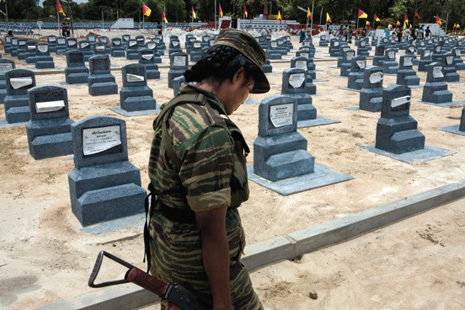Ilankai Tamil Sangam30th Year on the Web Association of Tamils of Sri Lanka in the USA |
|||
 Home Home Archives Archives |
Death of the TigerSri Lanka's Brutal Victory Over it Tamil Insurgentsby Jon Lee Anderson, The New Yorker, January 17, 2011
Audio: Jon Lee Anderson discusses the devastating end of a brutal conflict.
ABSTRACT: A REPORTER AT LARGE about Sri Lanka’s brutal victory over its Tamil terrorists. When the end came for the Liberation Tigers of Tamil Eelam, in May, 2009, it was overwhelming and unmerciful. In a three-year offensive of increasing sophistication, the Sri Lankan Army outmaneuvered one of the world’s most ruthless insurgent armies. The battlefield defeat ended a vicious conflict that for twenty-six years had divided Sri Lanka along ethnic lines, as the country’s Tamils, a mostly Hindu minority, fought for the creation of a separate state against the ruling majority of Sinhalese Buddhists. The L.T.T.E. was led by Velupillai Prabhakaran, who had become one of the most successful guerrilla leaders of modern times. The Tigers were persistent suicide bombers, as well as relentless guerrilla fighters, and the war took at least a hundred thousand lives in Sri Lanka. To the extent that a counter-insurgency campaign can be successful, Sri Lanka is a grisly test case for success in modern warfare. The Tigers’ collapse began in January, 2009, when they lost the town of Kilinochchi, their de-facto capital. By May, their remaining fighters retreated into the jungle near the coastal town of Mullaittivu, taking along more than three hundred thousand Tamil civilians who were trapped with them. The Sri Lankan Army designated a series of “no-fire zones” and told civilians to assemble there. It then shelled those zones repeatedly, while issuing denials that it was doing so and forbidding journalists access to the area. Hemmed in by the sea, a lagoon, and a hundred thousand government soldiers, the Tigers were all but helpless. On May 16th, the Army commander, General Sarath Fonseka, declared victory. Two days later, the Army announced that the Tiger leader, Velupillai Prabhakaran, had been killed. After the carnage, President Mahinda Rajapaksa’s government adopted a posture of triumphalism at home and resentment of the outrage it caused abroad. The important thing, Sri Lanka’s High Commissioner in London said, was that Sri Lanka had ended terrorism, making it the first country in the modern age to have done so. Describes the history of ethnic tensions and the civil war between the Tamils and the Sinhalese. Until the very end, Velupillai Prabhakaran believed that the international relief community, the U.N., and Western governments would save the Tigers. “The L.T.T.E. continued to read the world as if it was pre-9/11,” Jayampathy Wickramaratne, an adviser to Sri Lanka’s past two Presidents, explained. President Rajapaksa had described his postwar vision as “one nation, one people,” but many Tamils believed that this was simply the first step toward complete Sinhalese domination. In the months after the war’s end, lawyers in the U.S. Justice Department began exploring the possibility of war-crimes prosecutions of the Minister of Defense Gotabaya Rajapaksa, the President’s brother, as well as the former Army commander Sarath Fonseka. President Rajapaksa, meanwhile, has signed a number of economic deals with China. Mentions James Clad and Lasantha Wickrematunge. Many of the Tamils the writer encountered felt that the peace was perilously fragile. It should not be forgotten that the more successful counter-insurgencies, like Sri Lanka’s, are ugly in practice. Read more http://www.newyorker.com/reporting/2011/01/17/110117fa_fact_anderson#ixzz1AeYBuQsx --------------------------------------------------------------------------------------------------------- Back Issues: Sri Lanka Posted by Jon Michaud In this week’s issue, Jon Lee Anderson writes about the bloody conclusion to the decades-long insurgency fought by the Tamil Tigers against the Sri Lankan Army. He notes that “with the Tigers’ defeat … all of Sri Lanka’s territory came under government control for the first time in nearly thirty years.” The New Yorker has published a number of dispatches from Sri Lanka since the island (formerly known as Ceylon) gained independence from the British Empire in 1948. In 1958, Mollie Panter-Downes, who was then the magazine’s London correspondent, wrote a Letter from Ceylon in which she reported on disastrous floods that had afflicted the island at the end of the previous year. Panter-Downes also addressed the fear that the newly-independent Ceylon would turn Communist:
Panter-Downes also sensed the ethnic and religious tensions that would eventually lead to the war between the Tamil insurgents and the Sinhalese majority:
The promulgation of Sinhalese as the island’s official language was a turning point in the history of Sri Lanka. In 1988, Mary Anne Weaver wrote “The Gods and the Stars,” in which she described the results of the new law:
In her piece, Weaver chronicles the rise of the Tamil Tiger leader Velupillai Prabhakaran and his 1983 attack on an Army convoy in Jaffna, which sparked the violence that beset the country on and off for the next thirty years. Philip Gourevitch visited Sri Lanka in the aftermath of the December, 2004 tsunami in which, as he wrote, “more than thirty thousand people had been killed in the space of a few minutes.” Gourevitch reported that
Gourevitch’s article begins with the rumor that the Tiger leader Prabhakaran had been killed in the tsunami, which had devastated the coastal town of Mullaittivu, home to his headquarters. The rumors were false, but Mullaitivu was where the Tigers’ final stand against the Sri Lankan Army took place in May of last year. As Anderson writes in his article:
Read more http://www.newyorker.com/online/blogs/backissues/2011/01/sri-lanka.html#ixzz1AeYpv9z7
|
||
|
|||
